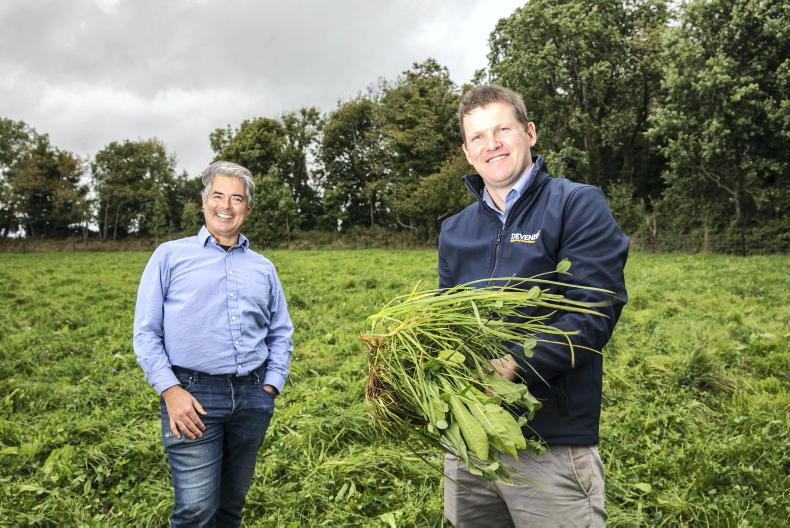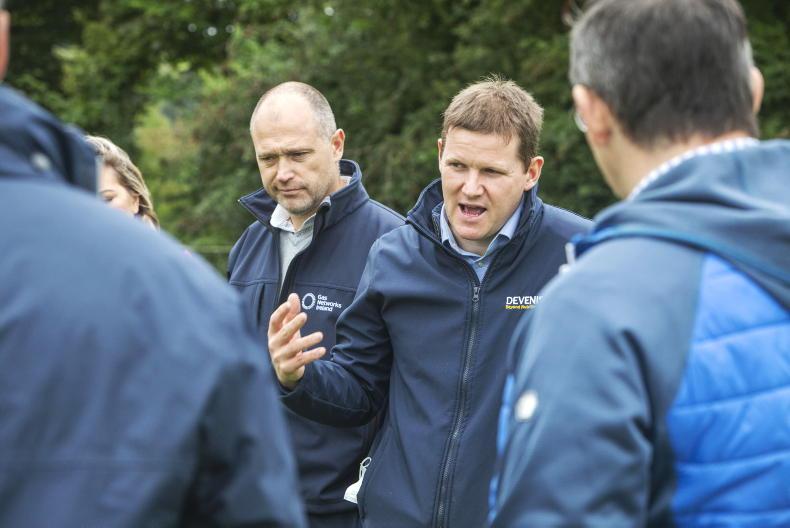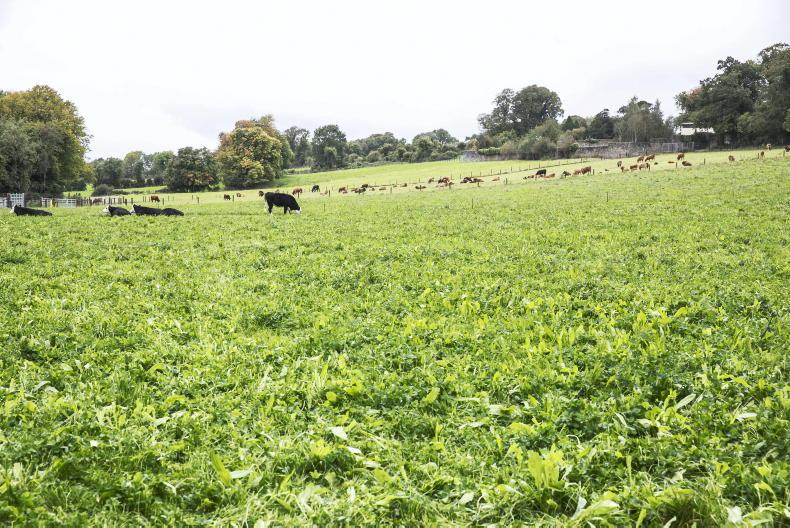A new report published on the environmental sustainability of biomethane aims to address the concerns about developing a large-scale agricultural anaerobic digestion (AD) industry in Ireland.
Although AD is considered a proven technology, there have been a number of environmental and economic concerns cited which have hampered its development and policy support in Ireland.

Ian O’Flynn Head of Commercial and Corporate Affairs at Gas Networks Ireland with David Hagan, Sustainable
The report, commissioned by Gas Networks Ireland and produced by KPMG and the Dowth Farm & Research Facility aims to address this.
Feedstock
The report outlines that, in order to meet a suggested target of 2.5 terawatt-hours of biomethane by 2030, 50,000ha of agricultural land would be required to produce 2.6m tonnes (0.6mt DM) of plant-based feedstock for 125 AD plants.
This is 1.1% of Ireland’s agricultural land base and is the equivalent to 5% of the current volume of grass silage produced annually. The network of AD plants would also require 1.75m tonnes of slurry, equivalent to 4% of the slurry currently captured in Ireland.
Competition
A recent concern expressed by the Irish Creamery Milk Suppliers Association was in relation to the competition which a network of AD plants could pose to land availability for the dairy industry.
However, the report analysis shows that Ireland could produce an additional 3.1mt DM of feedstock from improved efficiency across land already in agricultural production.
The report authors say this wouldn’t impact feedstock currently used for livestock or utilising biodiverse or high nature value farmland.

David Hagan, Sustainable Agricultural Manager at Devenish Nutrition talking to representatives of Gas Networks Ireland
They say this can be achieved by optimising soil fertility and agronomy, increasing average grass growth to 10t DM/ha rather than the current 6t DM/ha. If this is achieved over 154,000ha, it will produce the required feedstock for the network.
The report largely focuses on grass and MSS but does outline that tillage land in Ireland could provide extra forages for AD plants
The report also examined the role of multispecies swards (MSS) which, in trials in Dowth, has shown further yield increases from 10t DM/ha to 12-13t DM/ha in addition to reducing the fertiliser requirement by approximately 58%. MSS also have significant benefits for above- and below-ground biodiversity.

A field with a crop of multi species swards at Dowth Research Farm
The report largely focuses on grass and MSS but does outline that tillage land in Ireland could provide extra forages for AD plants through the use of temporary lays and growing energy-rich crops such as maize or sugar beet.
Inputs
In the short-term (approximately five years), the report suggests more fertiliser and lime inputs will be needed to build soil fertility. However, once the initial fertility deficit is addressed, the report suggests it is possible to produce the feedstock with significantly lower inputs, much of which will be met with digestate upgraded organic biofertiliser.
A new report published on the environmental sustainability of biomethane aims to address the concerns about developing a large-scale agricultural anaerobic digestion (AD) industry in Ireland.
Although AD is considered a proven technology, there have been a number of environmental and economic concerns cited which have hampered its development and policy support in Ireland.

Ian O’Flynn Head of Commercial and Corporate Affairs at Gas Networks Ireland with David Hagan, Sustainable
The report, commissioned by Gas Networks Ireland and produced by KPMG and the Dowth Farm & Research Facility aims to address this.
Feedstock
The report outlines that, in order to meet a suggested target of 2.5 terawatt-hours of biomethane by 2030, 50,000ha of agricultural land would be required to produce 2.6m tonnes (0.6mt DM) of plant-based feedstock for 125 AD plants.
This is 1.1% of Ireland’s agricultural land base and is the equivalent to 5% of the current volume of grass silage produced annually. The network of AD plants would also require 1.75m tonnes of slurry, equivalent to 4% of the slurry currently captured in Ireland.
Competition
A recent concern expressed by the Irish Creamery Milk Suppliers Association was in relation to the competition which a network of AD plants could pose to land availability for the dairy industry.
However, the report analysis shows that Ireland could produce an additional 3.1mt DM of feedstock from improved efficiency across land already in agricultural production.
The report authors say this wouldn’t impact feedstock currently used for livestock or utilising biodiverse or high nature value farmland.

David Hagan, Sustainable Agricultural Manager at Devenish Nutrition talking to representatives of Gas Networks Ireland
They say this can be achieved by optimising soil fertility and agronomy, increasing average grass growth to 10t DM/ha rather than the current 6t DM/ha. If this is achieved over 154,000ha, it will produce the required feedstock for the network.
The report largely focuses on grass and MSS but does outline that tillage land in Ireland could provide extra forages for AD plants
The report also examined the role of multispecies swards (MSS) which, in trials in Dowth, has shown further yield increases from 10t DM/ha to 12-13t DM/ha in addition to reducing the fertiliser requirement by approximately 58%. MSS also have significant benefits for above- and below-ground biodiversity.

A field with a crop of multi species swards at Dowth Research Farm
The report largely focuses on grass and MSS but does outline that tillage land in Ireland could provide extra forages for AD plants through the use of temporary lays and growing energy-rich crops such as maize or sugar beet.
Inputs
In the short-term (approximately five years), the report suggests more fertiliser and lime inputs will be needed to build soil fertility. However, once the initial fertility deficit is addressed, the report suggests it is possible to produce the feedstock with significantly lower inputs, much of which will be met with digestate upgraded organic biofertiliser.









 This is a subscriber-only article
This is a subscriber-only article














SHARING OPTIONS: